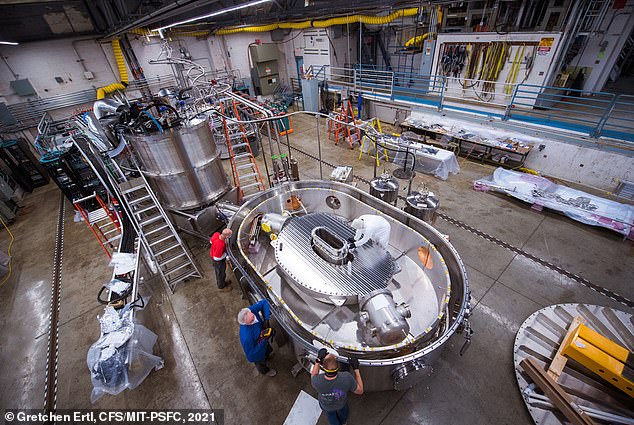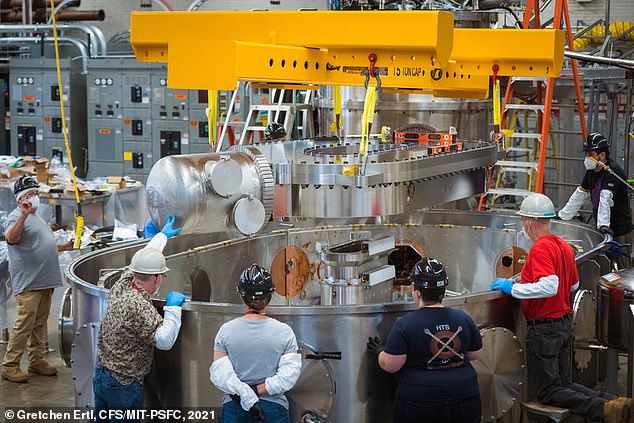Fusion Energy Is Coming, and Maybe Sooner Than You Think
The joke about fusion energy is that it will always be 30 years away, - always. But significant recent advances in fusion science and technology could potentially put the first fusion power on the grid as soon as the late 2030's. See video below.
When British physicist Arthur Stanley Eddington first proposed in the 1920s that the sun and stars were powered by the fusion of hydrogen into helium, his idea sparked a rush of research and speculation into the possibility of bringing this energy source to earth. It was not long before journalists and pulp fiction authors were predicting a time, surely not far away, when the world would be powered by simple fusion reactors requiring nothing more than abundant hydrogen isotopes from sea water.
Obviously, these early predictions were more than a little off-base. Vastly more is understood about the physics of fusion energy than in Eddington’s day, yet commercial electricity generation from fusion still remains a goal rather than a reality. Decades of overly enthusiastic predictions have led to a long-running joke that fusion is the energy source of the future—and always will be. But no more.
This is not hype, this is reality. Nuclear fusion gets a step closer to reality as scientists successfully test a magnet 12 times as powerful as those used in MRIs - with a working reactor slated within the next decade

Collaborative team working on the magnet inside the test stand housed at MIT. Research,
construction and testing of this magnet has been the single largest activity for the SPARC team,
which has grown to include 270 members
- MIT researchers created a new high temperature superconducting magnet
- This allows for it to be smaller than magnets used in other fusion experiments
- They achieved a strong magnetic field using a fraction of the normal power
- It used just 30 watts compared to the 200 million watts from other materials
- This is essential in developing a nuclear fusion reactor that is able to use less energy to start and operate than it is capable of producing
Nuclear fusion is a step closer to reality after scientists tested a magnet 12 times as powerful as those used for MRIs, with the hope of working reactors by the 2030s.
Unlike current nuclear fission technology, fusion replicates the process at the heart of stars, and produces clean, renewable power without the toxic waste.
Massachusetts Institute of Technology (MIT) scientists, working with Bill Gates-backed Commonwealth Fusion Systems (CFS), developed the magnet.
It is the world's strongest high temperature superconducting magnet and was tested at the MIT Plasma Science and Fusion Center in Cambridge, Massachusetts.
'This is not hype, this is reality,' Andrew Holland, Chief Executive Officer of the Fusion Industry Association, told CNBC. The test is significant because it produced a strong magnetic field required for the fusion process, while consuming just 30 watts of power.
When the MIT team use these magnets to build the first fusion machine, known as a tokamak, it is expected to generate more power than it uses to start and run.
During the test, the magnet at MIT reached 20 tesla - a unit of measurement showing the magnet's strength - and named for the engineer Nikola Tesla.
It did so while consuming just 30 watts of energy, orders of magnitude less than the copper-based magnet previously tested by MIT, which used 200 million watts.
This reduction in energy use is significant, as it means when they use the magnets to build the TOKAMAK it will achieve 'net energy' - the point where it takes less energy to initiate and sustain a reaction that it produces - making this test a significant milestone in an effort to create a 'sun on Earth' and provide cleaner, safer and renewable power, MIT said.
Magnets are a core component of the donut-shaped tokamak, as they hold in place the ball of plasma and energy as deuterium and tritium are fused into helium. Both are found in Sea Water.
There is a race to create viable fusion energy, with ITER, an international nuclear fusion research and engineering megaproject, about 75 per cent of the way there.
ITER hopes to achieve net energy by 2026, after completing all the magnets for their tokamak - although the ITER project won't sell energy, rather offer a blueprint for future fusion reactor designs to be used in any participating country.
However, the MIT team has managed to create a magnet that produces a magnetic field twice that of ITER's with a magnet about 40 times smaller.
The scientists from MIT and Commonwealth Fusion Systems said they may have a device ready for everyday use in the early 2030s.
'This was not designed to be a science experiment. This was designed to be commercial,' said MIT Vice President Maria Zuber, a prominent physicist.
Unlike existing fission reactors that produce radioactive waste and sometimes catastrophic meltdowns, proponents of fusion say it offers a clean and virtually limitless supply of energy, with a limitless supply of fuel. If, that is, scientists and engineers can figure out how to harness it - they have been working on the problem for nearly a century.
Rather than splitting atoms, fusion mimics a process that occurs naturally in stars to meld two hydrogen atoms together.
In this case they use deuterium and tritium, and produce a helium atom - as well as a whole load of energy. Achieving fusion requires unimaginable amounts of heat and pressure. One approach to achieving that is to turn the hydrogen into an electrically charged gas, or plasma, which is then controlled in a donut-shaped vacuum chamber.
With the magnet technology now successfully demonstrated, the MIT-CFS collaboration is on track to build the world's first fusion device that can create and confine a plasma that produces more energy than it consumes.
That demonstration device, called SPARC, is targeted for completion in 2025. 'The challenges of making fusion happen are both technical and scientific,' says Dennis Whyte, director of MIT's Plasma Science and Fusion Center, which is working with CFS to develop SPARC. But once the technology is proven, he says, 'it's an inexhaustible, carbon-free source of energy that you can deploy anywhere and at any time. It's really a fundamentally new energy source.'
This design was made possible by a new kind of superconducting material that became commercially available only a few years ago. Until now, the only way to achieve the colossally powerful magnetic fields needed to create a magnetic 'bottle' capable of containing plasma heated up to hundreds of millions of degrees was to make them larger and larger. 'It's a big moment,' says Bob Mumgaard, CEO of CFS. 'We now have a platform that is both scientifically very well-advanced, because of the decades of research on these machines, and also commercially very interesting. 'What it does is allow us to build devices faster, smaller, and at less cost,' he says of the successful magnet demonstration. The next step will be building SPARC, a smaller-scale version of the planned ARC power plant - a working prototype fusion reactor. The successful operation of SPARC will demonstrate that a full-scale commercial fusion power plant is practical, clearing the way for rapid design and construction of that pioneering device can then proceed full speed. Someday in a hoped-for future, when there may be thousands of fusion plants powering clean electric grids around the world, Zuber said. 'I think we're going to look back and think about how we got there, and I think the demonstration of the magnet technology, for me, is the time when I believed that, wow, we can really do this.' The successful creation of a power-producing fusion device would be a tremendous scientific achievement, Zuber notes. But that's not the main point. 'None of us are trying to win trophies at this point. We're trying to keep the planet livable.' Betting on nuclear energy is still the world's best chance drastically cut greenhouse gas emissions to zero by 2050, said Frederick Bordry, who oversaw the design and construction the Large Hadron Collider at CERN. 'When we speak about the cost of ITER, it's peanuts in comparison with the impact of climate change,' he said. 'We will have to have the money for it.'
Part relating to this story begins about 6:20 in

FLASH !
Scientists hit a key milestone in the quest to create abundant zero-carbon. limitless power through nuclear fusion. The Event took place at on Dec. 5th, 2022 when 192 giant lasers at the Lawrence Livermore Laboratory’s National Ignition Facility (NIF) blasted a small cylinder about the size of a pencil eraser that contained a frozen nubbin of hydrogen encased in diamond. Scientists have for the first time produced a fusion reaction that creates a net energy gain — a major milestone in the decades-long, multibillion-dollar quest to develop a technology that provides unlimited, cheap, clean power.
| Fusion efforts to date have primarily used doughnut-shaped reactors known as tokamaks. (<-- Left Column) The work at NIF takes a different approach, but so far, little work has gone into turning the idea of a laser fusion power plant into reality. “There are very significant hurdles, not just in the science, but in technology". NIF is the world’s most powerful laser, but it is a slow and inefficient one, relying on decades-old technology, where the laser beams entered at the top and bottom of the cylinder, vaporizing it. That generated an inward onslaught of X-rays that compresses a BB-size fuel pellet of deuterium and tritium, the heavier forms of hydrogen found in seawater. |